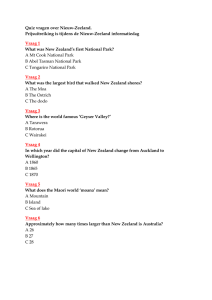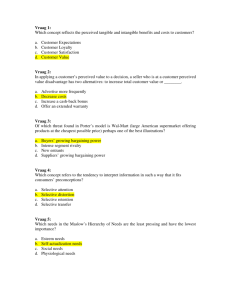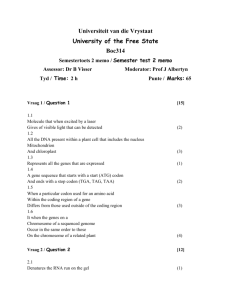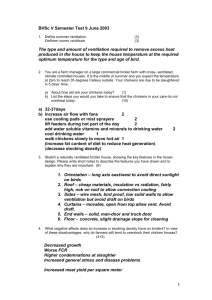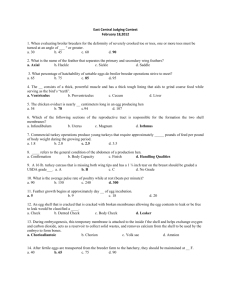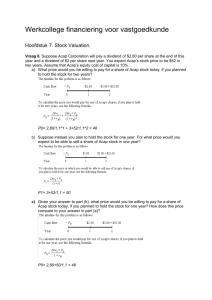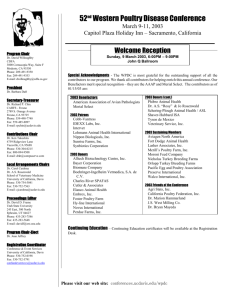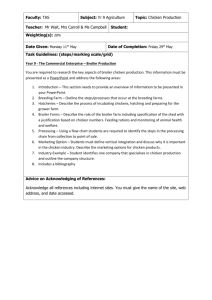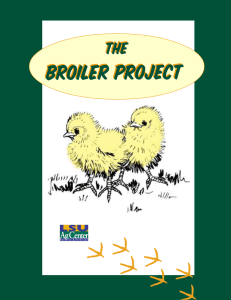BVSc V Poultry Examination 10 June 2004
advertisement
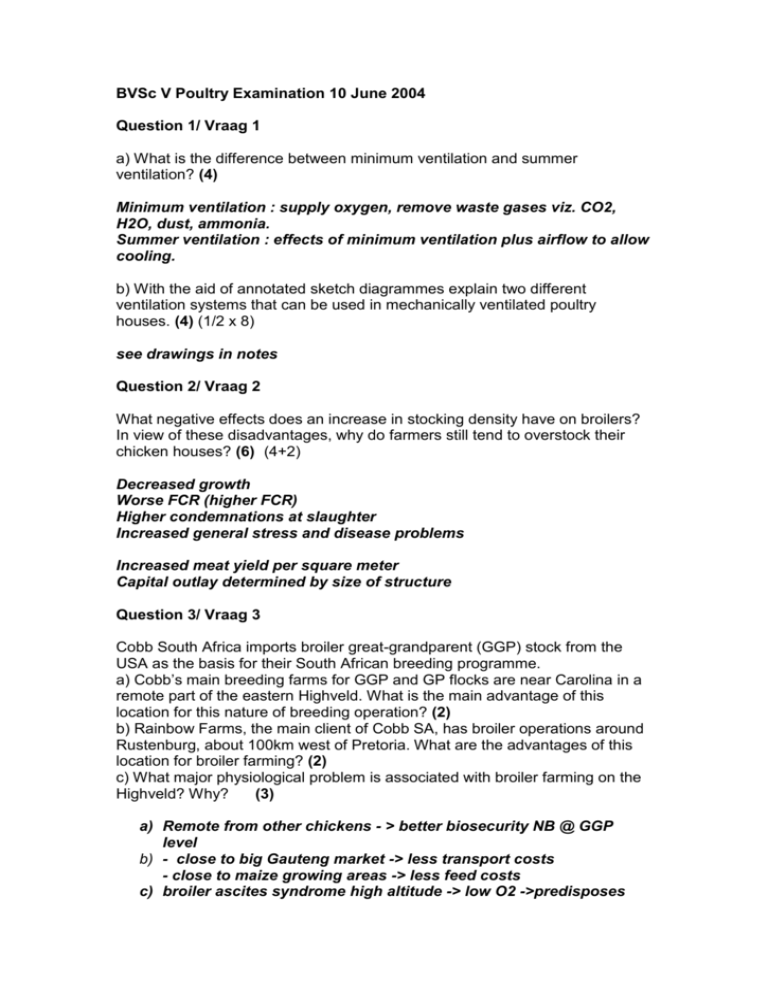
BVSc V Poultry Examination 10 June 2004 Question 1/ Vraag 1 a) What is the difference between minimum ventilation and summer ventilation? (4) Minimum ventilation : supply oxygen, remove waste gases viz. CO2, H2O, dust, ammonia. Summer ventilation : effects of minimum ventilation plus airflow to allow cooling. b) With the aid of annotated sketch diagrammes explain two different ventilation systems that can be used in mechanically ventilated poultry houses. (4) (1/2 x 8) see drawings in notes Question 2/ Vraag 2 What negative effects does an increase in stocking density have on broilers? In view of these disadvantages, why do farmers still tend to overstock their chicken houses? (6) (4+2) Decreased growth Worse FCR (higher FCR) Higher condemnations at slaughter Increased general stress and disease problems Increased meat yield per square meter Capital outlay determined by size of structure Question 3/ Vraag 3 Cobb South Africa imports broiler great-grandparent (GGP) stock from the USA as the basis for their South African breeding programme. a) Cobb’s main breeding farms for GGP and GP flocks are near Carolina in a remote part of the eastern Highveld. What is the main advantage of this location for this nature of breeding operation? (2) b) Rainbow Farms, the main client of Cobb SA, has broiler operations around Rustenburg, about 100km west of Pretoria. What are the advantages of this location for broiler farming? (2) c) What major physiological problem is associated with broiler farming on the Highveld? Why? (3) a) Remote from other chickens - > better biosecurity NB @ GGP level b) - close to big Gauteng market -> less transport costs - close to maize growing areas -> less feed costs c) broiler ascites syndrome high altitude -> low O2 ->predisposes marks were also given for respiratory problems associated with cold and dry winters Question 4/ Vraag 4 With reference to broiler breeder management, please answer the following questions. a) At what age is de-beaking usually done? (1) b) How is the growth rate of the birds controlled during rearing? (2) c) What biosecurity measures should be applied on broiler breeder rearing sites? (3) d) Why is separate sex feeding applied when broiler breeders are in production? (3) a) 7-21 days b) feed restriction based on weekly weights, feed composition c) limit access, showers, change clothes, vehicle control d) control relative growth rates, calcium levels, egg production, competition between sexes Question 5/ Vraag 5 Broilers: a) What behaviour in young chicks would indicate that they are too hot? (2) b) Aspergillosis is a common problem in newly hatched chicks. Where is the original source of this infection? What can be done to control the infection at this point in the production cycle? (3) c) Describe different types of drinkers used for broilers and explain their correct use. (6) a) move away from heat source, pant & spread wings b) litter in nestboxes, nestbox management, prillsetc. c) fonts young chicks, 1:100 chicks bell 1:100, at height of back, clean &check H2O level nipples 1:12-15, adj height to 60 degrees troughs not commonly used. Question 6/ Vraag 6 List the most important post mortem lesions you would expect to find in broilers infected by virulent Infectious Bursal Disease. (6) Haemorrhages in muscles Haemorrhages in proventriculus Haemorrhages in bursa Oedematous swollen bursa Nephrosis Congested carcass Question 7/Vraag 7 Newcastle Disease. a. Name the aetiological agent. (1) b. Name the 3 organ systems affected by Newcastle disease. (3) c. Describe the clinical picture in a flock of unvaccinated broilers affected by velogenic Newcastle disease. (4) d. Give the full name of a test used to differentiate the pathogenicity of different types of Newcastle disease virus. (1) e. Describe a typical vaccination programme against Newcastle disease in broilers. (4) a) Paramyxovirus b) GIT, respiratory, nervous c) >75% mortality, nervous signs, green diarrhoea, respiratory signs incl haem tracheitis. d) MDT or ICPI (in full) e) Live vaccines at day old, boost between 10 and 21 days, second booster Question 8/Vraag 8 You are in practice near Kyalami, it is late in the summer and one of your very important horse owners phones to tell you that her daughter’s bantams recently hatched a clutch of eggs. The chicks did fine for the first few weeks but have now developed “lumpy wart-like things” all over their faces and are not doing at all well, in fact three of the chicks have already died and she is worried the four survivors will soon die too. a) Give the most likely viral aetiology for this problem. (1) b) Which test can be used to confirm the diagnosis of this disease and what will be observed? (3) c) How would you advise control of the disease under the circumstances? (3) d) How is this disease controlled in commercial poultry operations – please give the control measure and its application. (3) a) fowl pox b) histopathology; intracytoplasmic inclusions (Bollinger bodies) c) antibiotics, mosquito control, supportive care, consider vaccination d) live vaccinationat 4-9 weeks, wing- web stab Question 9/ Vraag 9 a) List three diseases caused by haemagglutinating viruses in chickens. (3) b) Name the virus responsible for each of these diseases. (3) c) Without going into the actual nature of how the test works; explain how the haemagglutination inhibition test can be used to assist a veterinarian to make a diagnosis in a disease outbreak in chickens. (3) a) ND, AI, EDS b) paramyxovirus, orthomyxovirus, adenovirus c) test for antibodies in serum/blood, paired samples, increased titre (this was very badly answered!) some marks also given for HI use in virus isolation,but not for use of HA Question 10/ Vraag 10 a) Name two moderately and two highly pathogenic coccidia species in chickens and give their location in the gut. (4) (1/2 x 8) b) You carry out a chicken post mortem at your veterinary practice. What simple diagnostic test can you use to confirm a diagnosis of coccidiosis? How would you use this test to differentiate coccidiosis from necrotic enteritis? (3) c) What drugs would you use to treat an acute outbreak of coccidiossis and what route of administration would you use? (2) d) Give an example of a coccidiostat rotation programme used in the prevention of coccidiosis. (5) a) moderately: E. acervulina, E. maxima highly: E. tenella, E. necatrix b) wet scraping of gut, oocysts vs.gram positive rods c) sulphonamides or diclazuril in water d) see attached hand out as an example Question 11/ Vraag 11 Fowl typhoid. a) Name the causative agent. (1) b) What age of birds are affected? (2) c) Describe the characteristic post mortem lesions. (4) a) Salmonella gallinarum b) older birds, usually in lay c) Bronze coloured , enlarged liver, splenomegally, grey coloured lungs, catarrhal enteritis, anaemia,septicaemic carcass. Question 12/ Vraag 12 Infectious coryza. a) Name the causative agent. (1) b) Give the growth requirements for the bacteria to be isolated in the laboratory. (5) c) Give your first choice drug for treatment in an outbreak. (1) a) Haemophilus paragallinarum b) Microaerobic and high humidity, 1% chicken serum x-factor, NAD (V) factor dependant or independent, satellitism c) Sulphonamides/Quinolones Question 13/Vraag 13 Discuss the control of Mycoplasma gallisepticum in a broiler breeder flock under the following headings: biosecurity, disease monitoring, treatment & its aims and vaccination. (11) Biosecurity: purchase MG free chicks general access control to farm Serology: ELISA/plate tests regular intervals confirmation by PCR or culture Treatment: slaughter (possibly) treat chronically with acutely in water with quinolone, then in-feed with macrolide or tetracycline Aim of Rx: avoid egg prod. drop, avoid vertical transmission Vaccination: live TS11, dead bacterin
